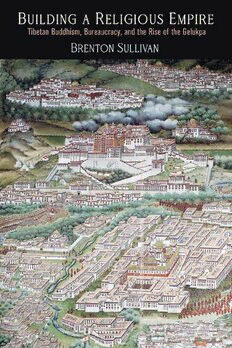
Building a Religious Empire: Tibetan Buddhism, Bureaucracy, and the Rise of the Gelukpa (Encounters with Asia) PDF
Preview Building a Religious Empire: Tibetan Buddhism, Bureaucracy, and the Rise of the Gelukpa (Encounters with Asia)
Building a Religious Empire ENCOUNTERS WITH ASIA Victor H. Mair, Series Editor Encounters with Asia is an interdisciplinary series dedicated to the exploration of all the major regions and cultures of this vast continent. Its time frame extends from the prehistoric to the con temporary; its geographic scope ranges from the Urals and the Caucasus to the Pacific. A part icu lar focus of the series is the Silk Road in all of its ramifications: religion, art, m usic, medicine, science, trade, and so forth. Among the disciplines represented in this series are history, archaeology, anthropology, ethnography, and linguistics. The series aims particularly to clarify the complex interrelationships among vari ous p eoples within Asia, and also with socie ties beyond Asia. A complete list of books in the series is available from the publisher. BUILDING A RELIGIOUS EMPIRE Tibetan Buddhism, Bureaucracy, and the Rise of the Gelukpa Brenton S ullivan university of pennsylvania press philadelphia Copyright © 2021 University of Pennsylvania Press All rights reserved. Except for brief quotations used for purposes of review or scholarly citation, none of this book may be reproduced in any form by any means without written permission from the publisher. Published by University of Pennsylvania Press Philadelphia, Pennsylvania 19104–4112 www . upenn . edu / pennpress Printed in the United States of Ameri ca on acid- free paper 10 9 8 7 6 5 4 3 2 1 Library of Congress Cataloging- in- Publication Data Names: Sullivan, Brenton, author. Title: Building a religious empire: Tibetan Buddhism, bureaucracy, and the rise of the Gelukpa / Brenton Sullivan. Other titles: Encounters with Asia. Description: 1st edition. | Philadelphia: University of Pennsylvania Press, [2021] | Series: Encounters with Asia | Includes bibliographical references and index. Identifiers: LCCN 2020015353 | ISBN 9780812252675 (hardcover) Subjects: LCSH: Dge-lugs-pa (Sect)—China—Tibet Autonomous Region—History. | Dge-lugs-pa (Sect)— Tibet Region—History. | Buddhist monasteries—China— Tibet Autonomous Region—History. | Buddhist monasteries— Tibet Region— History. | Buddhist monasticism and religious orders—Government—History. | Buddhism—China—Tibet Autonomous Region—History. | Buddhism—Tibet Region—History. Classification: LCC BQ7576 .S85 2021 | DDC 294.3/9 2309—d c23 LC record available at https://lccn.loc.gov/2020015353 Contents A Note on Language and Romanization vii Introduction 1 Chapter 1. The Geluk School’s Innovative Use of Monastic Constitutions 25 Chapter 2. Administering a Monastery for the “Common Good” 56 Chapter 3. Institutionalizing Tantra 89 Chapter 4. The Systematization of Doctrine and Education 113 Chapter 5. Singing Together in One Voice 133 Conclusion 169 Appendix. Monastic Constitutions to the Mid-E ighteenth Century 177 Notes 185 Bibliography 243 Index 265 Acknowle dgments 279 A Note on Language and Romanization This book examines the expansion of the Geluk school of Tibetan Buddhism from its early base in Central Tibet, near the southern edge of the Tibetan Plateau, across the Tibetan Plateau and into Mongolia and parts of East Asia (particularly through its engagement with the Qing Court in Beijing). As a result, names and terms from a variety of languages, especially Tibetan (T.), Mongolian (Mo.), Chinese (Ch.), and Manchu (Ma.), appear in the relevant primary sources. Chinese names and terms are transcribed using Pinyin. Mongolian names and terms follow the forms given in Christopher Atwood’s Encyclo- pedia of Mongolia and the Mongol Empire (2004). Manchu names and terms are transcribed according to Jerry Norman’s Comprehensive Manchu- English Dictionary (2013). Tibetan names and terms have been phoneticized in the body of the text using the Tibetan and Himalayan Library (previously the Tibetan and Himalayan Digital Library) Simplified Phonetic Transcription of Standard Tibetan (2003), developed by David Germano and Nicolas Tournadre. This system makes Tibetan names and words more or less pro- nounceable by the English- reading audience and does so in a consistent fashion according to the general rules of pronunciation in Central Tibet. Tibetan names and terms in the notes of the text are rendered using the Wylie transliteration system as described by Turrell Wylie (1959). Introduction Building a Religious Empire is focused on the story of the Geluk (T. Dge lugs) school of Tibetan Buddhism, the most widespread school of Tibetan Bud- dhism, best known through its symbolic head, the Dalai Lama. The vast majority of the monasteries in Tibet and Inner Mongolia— a landscape that makes up a third of the territory of today’s China—as well as those in Mon- golia are Geluk monasteries. Historically, these monasteries were some of the largest in the world, and even today some of the largest Geluk monas- teries house thousands of monks both in Tibet and in exile in India. To un- derstand how this came to pass, this book reveals the compulsive efforts by Geluk lamas in the early modern period to prescribe and control a proper way of living the life of a Buddhist monk and to define a proper way of ad- ministering the monastery. These lamas drew on the sort of administrative techniques usually associated with state- making— standardization, record- keeping, the conscription of young males, the concentration of manpower in central cores, and so on— thereby earning the moniker “lama official” or “Buddhist bureaucrat” (T. bla dpon). They also thereby succeeded in estab- lishing a relatively uniform and resilient network of monasteries stretching from Ladakh to Lake Baikal, from Beijing to the Caspian Sea. Previous explanations of this success of the Geluk school over other schools of Tibetan Buddhism have focused on the brilliance of its founder or on the role played in later centuries by the school’s power ful Mongol pa- trons in eliminating, often violently, rivals. What has not been appreciated is the zeal and thoroughness with which Geluk lamas or ga nized, system- atized, and administered their monasteries, thereby giving rise to a uniform and hegemonic school of Tibetan Buddhism. It is the deployment of bu- reaucratic techniques usually associated with the state for the purpose of
